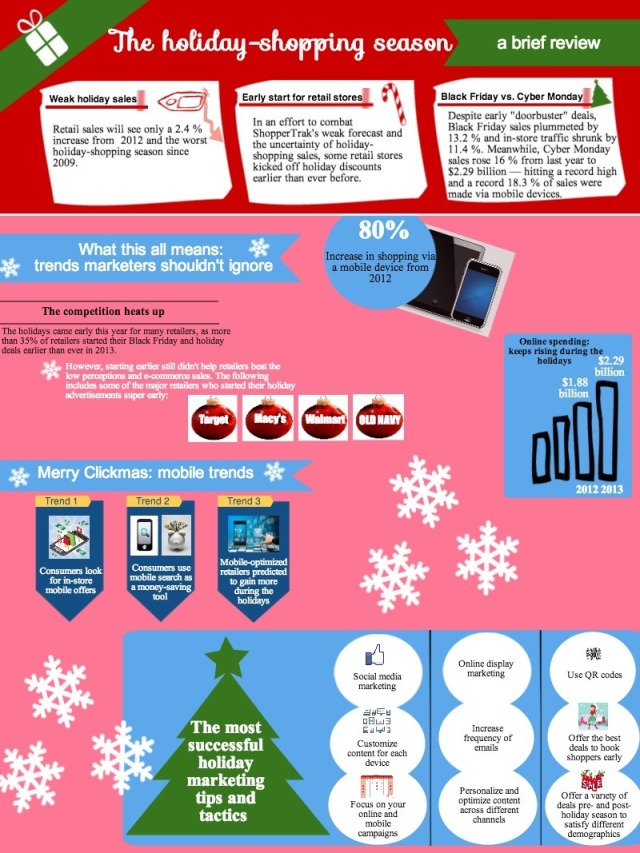Will marketers and retail stores land on Santa’s naughty or nice list this year?
It’s that time a year again — the holidays are upon us and the holiday-shopping season is in full swing.
Yet retail analytics firm ShopperTrak predicts the sales this holiday season will be the worst since 2009. Consequently, some concerned retailers reacted by jumpstarting their holiday marketing efforts to offer seasonal discounts earlier than ever.
“Kicking off the holiday season with early bargains, such as Black Friday or should I say ‘Black Thanksgiving,’ actually hurts retailers. And retail stores lose so much money from starting the holiday deals early,” said Cory Williams, supervisor and marketing intern at Lucky Brand in Del. “For instance, the Lucky Brand store I work at made $27,000 on Thanksgiving evening and Black Friday combined — making $4,000 less than last year. Without the holiday deals, we could have made around $55,000.”
Then, proving the forecast for a weak holiday season, Black Friday sales plummeted despite retail stores — such as Target and Macy’s — opening their doors at 8 p.m. on Thanksgiving and staying open through Black Friday.
“I believe holiday sales are down because the shopping culture has shifted. People would rather stay in the comfort of their own homes and shop online instead of leaving their families on Thanksgiving to get the Black Friday doorbusters,” said Jon Pepper, a public relations (PR) major and AJF-PRSSA’s PR director at Rowan University.
Despite the reduction of Black Friday sales, Cyber Monday sales hit a record high — indicating that online shopping for holiday gifts increased and turned into a bigger trend.
“The increased emphasis on online discounts caused a decrease for in-store sales,” said Pepper. “Now, stores must compete in the e-commerce realm in order to stay relevant.”
So, in a down economy — how can marketers grab consumers attention to drive them through store doors, open their wallets and earn their business?
Williams, as a retail and marketing expert, suggests that retailers can combat the low projection of holiday sales by cranking up and customizing their online and in-store efforts to make consumers feel special.
Even as a consumer, Pepper’s recommendations are similar and he said, “Retailers should go back to focusing more on their consumers’ needs.”
Furthermore, in today’s economy, research studies and news stories help show that it’s all about consumers being able to get the most bang for their buck.
“In-store perks [such as coupons, discounts or other events] work best to get my business. For instance: During GameStop’s holiday sales [which the company advertises online] — if you buy two used games, you get one free. This clearly describes the benefit of shopping with them and is a nice bonus. ‘Who doesn’t love free stuff?'” said Pepper.
But what does this all mean? Does this mean that retailers will have to continue starting earlier and keeping up with online marketing trends to get you through their doors?
According to Williams and Forbes — the traditional marketing model left and may not come back, and marketers may need to recalibrate their approaches in marketing to consumers for 2014.
“The fact that cyber sales are at an all-time high shows a clear change in consumer behavior, but it also shows a shift in retail tactics,” said Pepper. “Many retailers, such as Target, offer online sales in addition to in-store deals. After all, online, social media and mobile advertising have become the biggest, most efficient mediums to reach the consumers. It is easier to drive traffic to online and mobile sites from social media and online advertising than it is to bring customers to the store.”
And with the changing nature of marketing to consumers, it’s harder for marketers to make their advertisements standout during the holidays. In general, people have learned to tune out advertising — especially, during the holidays. We’re so used to seeing “save this” or “buy here” that it becomes so natural to disregard advertisements.
If marketers keep up with the game-changing trends, will their strategies and tactics persuade consumers to go on gift-buying shopping sprees before the holidays are over — or will the holiday season leave behind a lump of coal?
Most news articles and shopping studies point to coal. But both Williams and Pepper argue that if marketers and retailers use new marketing trends — mixed with original, simple (easy to understand) and concise advertisements that show a brand’s value to consumers — then Santa may leave increased sales revenue in retails stores’ stockings.
Check out the following infographic I made to elaborate on this information and tie it into a bow:
Sources for this infographic’s information: ShopperTrak and Adobe Digital Index 2013.

